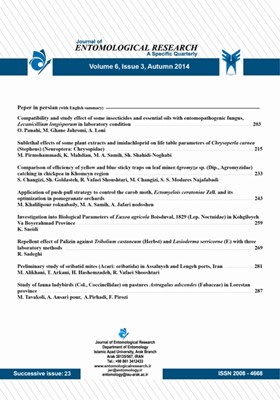Sublethal effects of some plant extracts and imidachloprid on life table parameters of Chrysoperla carnea (Stephens) (Neuroptera: Chrysopidae)
Subject Areas : entomology and othea arthropodsM. Pirmohammadi 1 , K. Mahdian 2 * , M. A. Samih 3 , Sh. Shahidi-Noghabi 4
1 - Department of Plant Protection, Faculty of Agriculture, Vali-e-Asr University, Rafsanjan, Iran
2 - Department of Plant Protection, Faculty of Agriculture, Vali-e-Asr University, Rafsanjan, Iran
3 - Department of Plant Protection, Faculty of Agriculture, Vali-e-Asr University, Rafsanjan, Iran
4 - Department of Plant Protection, Faculty of Agriculture, Vali-e-Asr University, Rafsanjan, Iran
Keywords:
Abstract :
Present study was conducted to evaluate the side effects of the extract of Calotropis procera (Wit.) (Asclepiadaceae), Lawsonia inermis L. (Lythraceae)andRicinus communis L. (Euphorbiaceae) in comparision with imidachloprid on life table parameters of Chrysoperla carnea (Stephens) under controlled condition. Life table of 25 first instar larvae of C. carnea that exposed to sublethal concentration of chemicals (i.e., LC25) were studied using a completely randomized design with four replicates. The 1st instar larvae of C. carnea (n=100) were treated to sublethal concentration of the extracts and imidachloprid by Potter Spray Tower. The life table data were analyzed by Age-stage, two-sex life table. R. Communis extraction caused the lowest survival rate (57 days) and oviposition period (52 days). The results of population parameters in first instar larvae of C. carnea revealed that there were significant differences between net reproductive rate (R0 or NRR), gross reproductive rate (GRR), intrinsic rates of increase (rm), finite rate of increase (λ) and mean generation times (T). Significant differences were found among all treatments and control in intrinsic rates of increase parameter. This parameter significantly decreased in treatments of L. inermis, imidaclopridand R. Communis. Intrinsic rates of increase of L. inermis (0.076±0.002), imidachloprid (0.077±0.002), R. communis (0.082±0.003) and C. procera (0.095±0.004) were significantly lower than control (0.110±0.002).

